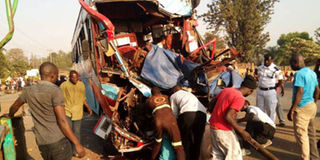Interventions required to reduce road traffic accidents

Speeding and overtaking are two worst traffic vices which often lead to road carnage. Therefore, all drivers must be careful and obey traffic rules. Courtsey photo
As Ugandans ushered in the Easter holiday on Good Friday, Anita Businge was mourning her only sister and three other relatives who died in a motor vehicle accident on Hoima Road. “I had stayed in Kampala to run different errands. While I relaxed at home, I received a phone call informing me of the sad news. It was the toughest moment of burying four relatives in one compound in one day,” Businge recalls.
The problem
Winstone Katushabe, the commissioner of Transport Regulation and Safety at the Ministry of Works and Transport, says as Uganda commemorates the UN Global Road Safety Week which will run from May 7 to May 13 under the theme “Leadership For Road Safety,” road crashes in Uganda still continue to be a challenge.
For example, the 2017 annual traffic report by the Uganda Police Force shows that 3,500 people, including Businge’s relatives, died in car crashes while 10,420 were seriously injured. Katushabe notes that 40 per cent of the fatalities were those between 25 to 44 years old, which age group he says is society’s most productive. He adds that pedestrians were the largest causalities accounting for 40 per cent of all causalities, followed by passengers at 27 per cent, and motorcyclists at 23 per cent.
Statistics
According to previous Uganda Police Force reports, until 2015, accident fatalities had been on a declining trend. In 2011, 3,343 people died in road crashes as other 14,438 were seriously injured the same year. In 2012, there was a slight decline of people who died due to road crashes, accounting for 3,124 while 13,137 were seriously injured. In 2013, 2,937 people died in road crashes while 12,754 were seriously injured.
In 2014, 2,845 people perished in road crashes while 13,516 were seriously injured. In 2015, 3,224 people died in road crashes and 13,736 were seriously injured.
Economic cost
According to the 2015 statistical abstract, where Uganda’s Gross Domestic Product (GDP) in 2014 was Shs72.127 trillion, although the emotional cost is immeasurable, the economic cost can be estimated at three per cent of GDP which was approximately Shs2.16 trillion during 2014 alone. The 2015 Global Status Report on Road Safety says low and middle income countries, Uganda inclusive, lose approximately three per cent of GDP as a result of road traffic crashes.
Current global trends
Katushabe highlights that globally, more than 1.25 million people die each year on the world’s roads, making road traffic injuries one of the leading causes of death globally. In addition to deaths on the roads, up to 50 million people suffer nonfatal injuries each year as a result of road traffic crashes, while there are also additional indirect health consequences that are associated with this growing epidemic.
Charles Ssebambulidde, the spokesperson of the traffic directorate, says: “Vehicles on the road increase every year and when they increase, road crashes equally increase. New roads are also constructed and as a result, several people put up trading centres. This means pedestrians will increase and these will be subjected to accidents, especially if they are not careful,” Ssebambulidde explains.
Proposed measures
Katushabe says the ministry is in the final stages of installing speed limiters in commercial vehicles. “Speed limiters come with GPS trackers and recorders of speeding alerts. They notify the regulator of any vehicle driving above the recommended speed,” Katushabe says.
The works ministry is also concluding draft regulations on licensing of goods vehicles starting from July 2019. There will also be accreditation of drivers for goods vehicles to ensure proper conduct on the road. This will be in addition to looking at the driver’s accident history, criminal record and carrying out eye tests.
Engaging municipalities
Ssebambulidde says the traffic directorate is not only engaging municipalities to construct walkways or flyovers for pedestrians but are also sensitising motorcyclists, especially those on safe riding applications such as Safe boda to lure their colleagues to embrace the same safe riding system.
To Ssebambulidde and Katushabe, boda boda riders have continued to cause a number of crashes, most of which lead to deaths, accounting for 40 per cent, which Katushabe observes calls for targeted enforcement.
Comparison
The 2015 Global Status Report on Road Safety indicates that Uganda has the lowest road fatality rates per 100,000 people at 27.3 compared to Rwanda at 32.1, Tanzania at 32.9 and Kenya at 29.1, while no data was available for Burundi.




